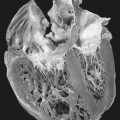89. Wolff-Parkinson-White Syndrome
Definition
Wolff-Parkinson-White syndrome (WPW) is a paroxysmal tachycardia or atrial fibrillation associated with a preexcitation syndrome, characterized by a short P-R interval and a wide QRS complex with an early QRS vector or delta wave.
Incidence
WPW sydrome is estimated to affect approximately 0.15% to 0.2% of the general population. Males are more frequently affected than females.
Etiology
WPW syndrome results from accessory electrical connections between the atria and ventricles produced by anomalous embryonic myocardial tissue development bridging the septa. The connections produced allow electrical conduction via sites other than the atrioventricular node (AV node). Bypass tracts may be numerous, including atriofascicular, fasciculoventricular, intranodal, and nodoventricular. The most common bypass is an accessory AV pathway called a Kent bundle. Kent bundle conduction can occur anterograde and/or retrograde.
Signs and Symptoms
• Atrial fibrillation
• Auscultated crackles over lung fields
• Circus movement tachycardias (regular, generally narrow-complex tachycardias)
• Diaphoresis
• Dizziness
• Hypotension
• Palpitations
• Short P-R interval plus wide QRS complex with delta wave
• Weakness
Medical Management
Treatment regimens/interventions are dictated by the specific dysrhythmia(s). Immediate treatment measures should include obtaining intravenous access, electrocardiographic monitoring, blood pressure, and pulse oximetry. Supplemental oxygen is appropriate and especially important if the patient is hypoxic.
The primary goal in treatment of WPW atrial fibrillation is to induce prolongation of the anterograde refractory period. However, so-called conventional pharmacologic atrial fibrillation treatment—calcium channel blockers, β blockers, and digoxin—may be very deleterious and can cause rhythm deterioration that leads to ventricular fibrillation. The patient with WPW atrial fibrillation should receive synchronized cardioversion as the first-line intervention, particularly if the patient’s condition is unstable. A hemodynamically stable patient may be treated medically, usually with a procainamide infusion.
Circus movement tachycardia should be treated so that the circus movement is broken and converted to a sinus rhythm. Cardioversion and adenosine are the common approaches used to achieve this goal. Adenosine is the first-line intervention when the patient is hemodynamically stable, but immediate cardioversion and full cardiac resuscitation equipment must be immediately on hand.
Complications
Any complications are attributable to the underlying condition.
Anesthesia Implications
The patient with WPW often presents for accessory pathway ablation. As such, pharmacologic interventions are frequently stopped to aid in inducing tachydysrhythmia. The patient is pharmacologically unprotected. Anxiolysis is important because it limits the chance of inducing a tachydysrhythmia in relatively uncontrolled surroundings, such as the patient’s room, the elevator, and/or anesthesia holding room. Relatively heavy premedication is most helpful in achieving the desired degree of anxiolysis. An untoward initiation of atachydysrhythmia may be controlled using very short-acting agents, such as amiodarone, flecainide, propafenone, or sotalol, even though these drugs may interfere with the proposed ablation procedure.
General anesthesia, if necessary, may be best induced with a version of total intravenous anesthetic (TIVA) that is predominately opioid/benzodiazepine based or opioid/propofol based and has demonstrated a lack of interference with electrophysiologic parameters in the associated accessory conduction pathways. For ablation procedures, volatile anesthetic agents are relatively contraindicated because of their ability to increase refractoriness within the accessory and atrioventricular pathways. However, when a patient with WPW presents for a procedure other than ablation, it may be beneficial to use general anesthesia with volatile anesthetic agents to take advantage of the increase in the refractoriness to prevent incitement of perioperative tachydysrhythmias.







